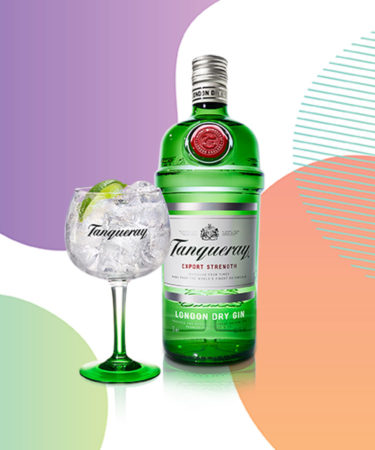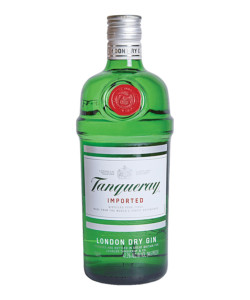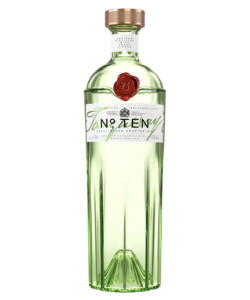Not only is Tanqueray almost 200 years into the gin game, the company actually helped drive the evolution of the category itself.
It was part of the mission to transform gin from “Christmas tree fire water” to something actually respectable.
From its role as early innovator in gin production to being one of the only things that could— and God forgive them — make Idris Elba look mildly unattractive, here are 11 things you need to know about Tanqueray.
-
Its founder defied God. Sort of.
Charles Tanqueray was born in 1810 to a long line of English clergymen — father, grandfather, even great uncle. Naturally, when it came time to pick a career, Tanqueray the younger went with booze, founding a distillery with his brother in London in 1830.
-
It was a choice between gin and horse feet.
According to former Tanqueray master distiller Tom Nichol, Charles Tanqueray “was a genius.” More accurately, “I think he was a genius who told everyone he was a genius,” Nichol says. We don’t know if Tanqueray was both annoying and super smart, but we do know he dressed like Santa Claus on a Tinder date and carried around a notebook filled with ideas. Among the more prominent: recipes for animal medicines and a supposedly “improved” horseshoe polish, since there’s nothing worse than bad horseshoe polish. We’re glad he went with gin.
-
Tanqueray’s tinkering led to modern craft gin.
When gin, and not equine toiletries, won out in Tanqueray’s heart, he dedicated himself wholly to improving what passed for gin at the time, taking on industry leaders Felix Booth and Alexander Gordon (he’d go on to partner with the latter). While developing what would become his flagship recipe, Tanqueray stumbled upon his preferred method for distilling botanicals into a small quantity of neutral grain spirit before distilling the larger batch for the final time. It was one of the first innovations in botanical infusion, central to the whole “how-is-this-delicious-gin-not-vodka?” question.
-
Tanqueray: a ‘simple’ recipe.
Gin production is relatively easy: There’s no malted barley that has to be blessed by a Celtic priest or banjo-serenaded bourbon barrels required. There’s only juniper. Many recipes go well beyond with unexpected ingredients — Scottish rowan berries, lavender, love — but for 180-plus years, Tanqueray stuck by the seemingly simple combination of only four botanicals: Tuscan juniper, coriander, angelica root, and licorice. But don’t let numbers fool you. With just those four botanicals, Tanqueray presents a blooming gin bouquet.
-
It’s (almost) Smirnoff.
They’re different beasts in the bottle, sure, but before botanicals come into play, vodka and gin can be (and often are) close to the same stuff. In the case of Tanqueray gin and Smirnoff vodka, they’re exactly the same stuff: Smirnoff and the base neutral spirit for Tanqueray are distilled at a facility called Cameron Bridge in Scotland before going off to become their respective final products, which proves — if nothing else — the surprising economic advantage of adding juniper to stuff before selling it.
-
It’s made with a 200-year-old still.
The still is nicknamed “Old Tom,” though it’s not to be confused with Tanqueray’s limited-release Old Tom gin, a slightly sweeter style that’s halfway between genever and London dry . This is a sturdy beast of a thing that somehow survived a London World War II air raid in 1941 and, after some repairs, became a kind of spiritual mascot for Tanqueray’s brand endurance.
-
Tanqueray 10 (obviously) has eight botanicals.
Tanqueray and Tanqueray 10 are the two Tanqueray products you’re most likely to see or have seen, drink or have drunk (or are drinking right now, nice). They both ring in at a solid 47.3 percent ABV, but Tanqueray has that aforementioned juniper assertiveness, whereas Tanqueray 10 was produced as a kind of concession to and/or celebration of the emerging craft gin market — a market reaching out to more consumers, including those less in love with gin’s signature juniper note. The result is a mix of eight botanicals (not 10, because why not?) that is less juniper-forward and overlaid with not just earthy spice but brighter, fragrant citrus notes.
-
From Presidents to Rat Packs, America loves Tanqueray.
According to Diageo archivist Joanne McKerchar, Tanqueray was the first drink poured in the White House after Prohibition was repealed in 1933. (Only fair, since Tanqueray also supposedly donated $1,000 to an “anti-dry” movement during Prohibition.) Then, in the 1960s, the Rat Pack realized they loved the stuff, too, famously putting down more than a few Tanqueray Martinis in the Buena Vista Social Club. Says McKerchar, “Sales of Tanqueray doubled in a year without a penny of advertising money being spent on the brand.”
-
Speaking of the Rat Pack, it was Frank versus the Tanq.
The Rat Pack had a controversial relationship with alcohol, and it turns out Frank Sinatra had his own love-hate relationship with gin. In the online forum Sinatrafamily.com, which looks like a (possibly authentic) family-run website dedicated to keeping “the legacy of Frank Sinatra safe and free,” one user asks, “Did Frank really drink gin? [S]omehow that surprises me.” Administrator Nancy — if we believe the site, Nancy Sinatra herself — replies simply and sadly: “Dad loved Tanqueray gin but it didn’t love him.”
-
The bottle is not a tiny fire hydrant.
Sure, we see a reasonable visual resemblance, but the Tanqueray bottle wasn’t based on a fire hydrant. The bottle was actually, and carefully, modeled after a cocktail shaker, a marketing attempt at aligning the strangely assertive flavors of English gin with the more approachable, mutable flavors of the American cocktail scene. When Tanqueray 10 launched in 2000, the company used a similar shape but added a not uncool retro citrus reamer vibe to play up the aforementioned citrus.
-
It’s the only thing that could make Idris Elba look awkward.
And let’s be clear: just barely. Considering the near-theoretical impossibility of catching someone who looks like this at a bad angle, it’s actually almost (almost) admirable that a Tanqueray print ad seems to capture Elba in an expression this unflattering.


